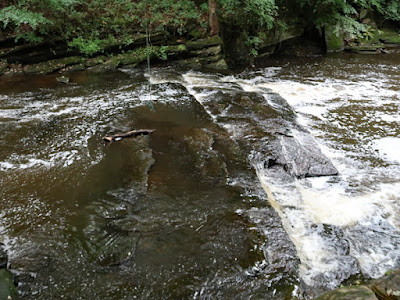In the latter part of June 2022, I had accompanied Barry Tylee on his recce of the area around Hunshelf, on the Sheffield/Barnsley boundary, for the August Sheffield U3A Geology Group and a few days after my visit to to the Yorkshire Natural History Museum, we set off on our field trip.
19 of us met up at the Cote Green car park and, once various preliminaries had been sorted, we set off to our first stop – the old Wortley railway station – where Barry explained the importance of the railway to the quarrying industry in Green Moor and other industries in the area.
Although Barry and I had crossed the River Don by the footbridge on our recce, several members chose to use the stepping stones instead, which are marked on the 1855 Ordnance Survey as a ford. We then traced our way down the path to the riverbank, where there are the remains of industrial infrastructure and some excellent exposures of the Greenmoor Rock.
The downside of a very large turnout of 19 members, on this occasion, was the need to spread out along a riverside path where there are no places the group to squeeze together to listen to the group leader. With Barry near to one end of the line of people – talking about the industrial archaeology - and me near to the other end to explain the geology, I am sure that only half of the group got to hear both sides of the story.
We continued our walk by ascending up the path through Tin Mill Rocher, seeing a few rock exposures at a high level and beyond our means of exploration. With a moderately steep ascent of a hundred metres in altitude to undertake, there was a noticeable lag between the time of the leader and the last group member arriving at our next stop - at the western end of Hunshelf Bank.
All along its outcrop of from Green Moor to Graves Park, the Greenmoor Rock has been extensively quarried to supply the dry stone walls along the length of the escarpment, which can be quite an art – as we had seen on the previous trip to Green Moor in 2017.
There are a few places here where the small delves can be clearly be seen and easily explored, yet Barry had for some reason walked straight past them, which we later discovered was because he had been feeling unwell and that he had forgotten about the geology.
Some of us stopped to have a quick look at the very irregularly bedded flaggy sandstone here, which is perfectly suited to dry stone walling but not for producing top quality paving stone, which once came from the thicker beds of Greenmoor Rock that overly them.
Following Barry to the site of the RIGS in Green Moor Delf, a remnant of the quarry face at the southern end of the large elongate quarry that once existed here. Having undertaken a few visits to this site, since an initial geological survey of Green Moor as part of the Stoneway Manor housing development, I pointed out various sedimentary structures that can be seen here.
We then headed back to Hunshelf Bank, passing the cricket ground and the Isle of Skye Quarry, before sitting down for our lunch at the top of the escarpment, which overlooks Stocksbridge and has great views of the moorland in the distance.
Barry formally announced that he had to get back to the centre of Green Moor to open up toilets for our group, so we gathered together at our leisure after lunch and eventually reconvened at the old pump house by the entrance to the Stoneway Manor estate. After explaining its history to the group, Barry took his leave and left myself and Catherine, an archaeologist friend of his and a new member of the group to lead us back to our starting point.
With several members of the group clearly afflicted by some injury or ailment, we decided not to go and explore the old quarries that overlook the south bank of the River Don. Instead, we walked down Well Hill to an old quarry in the Grenoside Sandstone, but the business there was about to close; however, with the owner recognising me from the recce with Barry, we managed to have a quick look at the geology before making our way back to the cars.













No comments:
Post a Comment